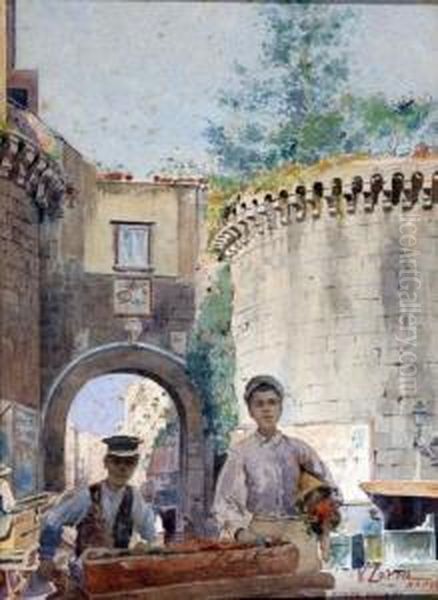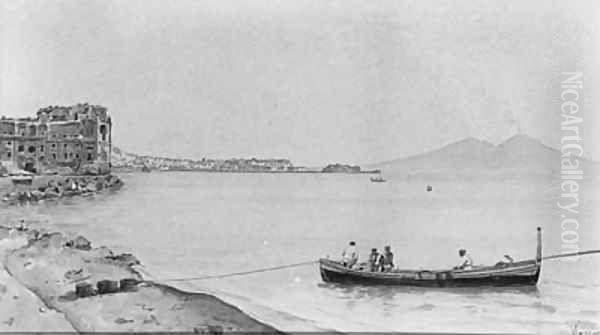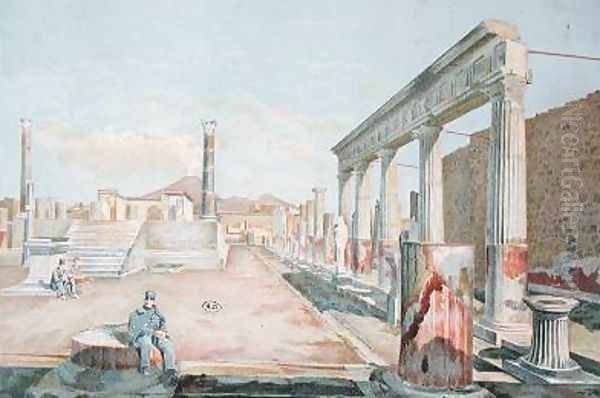Vincenzo Loria stands as a figure within the rich tapestry of late 19th and early 20th-century Italian art. Born in 1849 and passing away in 1939, his life spanned a period of significant artistic evolution in Italy and across Europe. Primarily known as a painter and illustrator, Loria dedicated his career to capturing the nuances of Italian landscapes, cityscapes, and occasionally, evocative human figures, working proficiently in both oil and watercolor.
Origins and Artistic Milieu
Vincenzo Loria entered the world in Mantua (Mantova), a city steeped in artistic heritage, famously associated with the Gonzaga court and Renaissance masters like Andrea Mantegna. While specific details about his formal training are not explicitly detailed in the provided sources, artists of his generation in Italy typically pursued education through regional academies (Accademie di Belle Arti) or apprenticeships with established masters. His formative years would have coincided with the later phases of the Risorgimento, Italy's unification movement, a period that fostered a renewed interest in national identity, often reflected in art through the depiction of local landscapes and traditions.
Loria eventually settled and passed away in Genoa (Genova), another major Italian port city with a distinct cultural identity. His lifespan placed him as a contemporary to various Italian art movements, including the lingering influence of Neoclassicism, the rise of Realism, the innovations of the Macchiaioli group, and the emergence of Symbolism and early Modernist tendencies. While his own style appears rooted in a more traditional, naturalistic approach, he operated within this dynamic artistic environment.
Artistic Style and Techniques
Loria's work is generally categorized within the Italian School, characterized by a commitment to representational accuracy, often infused with a sensitivity to light and atmosphere. His primary modes of expression were oil painting and watercolor, demonstrating versatility across different media.

His oil paintings, such as The Golden Headdress, showcase his ability to handle richer textures and deeper color saturation. This particular work, noted for its dimensions (21 x 16 inches or 53.5 x 40.5 cm) and signature placement (upper left), also hints at an engagement with Orientalist themes, a popular trend in European art during the 19th century where artists depicted scenes and subjects inspired by North Africa, the Middle East, and Asia, often emphasizing exoticism and decorative elements.
Loria was also adept with watercolor, a medium well-suited for capturing the fleeting effects of light and the specific ambiance of locations like Venice. Works like Mucche al pascolo (Cows Grazing or Cattle at Pasture) exemplify his skill in this technique, likely employing transparent washes and fluid brushwork to render pastoral scenes. The mention of ACQUERELLO SU CAROTA (possibly meaning watercolor on cardboard) further underscores his use of this medium. His style emphasized detailed observation and a faithful rendering of the natural world and architectural elements.
Predominant Themes and Subjects
A significant portion of Vincenzo Loria's known oeuvre focuses on landscapes and cityscapes, particularly capturing the unique character of Venice. His paintings often feature the iconic canals, bridges, and distinctive architecture of the city. Works explicitly mentioned include depictions of the famous Bridge of Sighs (Il Ponte dei Sospiri) and Venetian canals (Canale di Venice), suggesting a fascination with the city's romantic and picturesque qualities, continuing a long tradition of Venetian view painting, or vedute, famously practiced by artists like Canaletto and Francesco Guardi centuries earlier.
Beyond Venice, Loria also turned his attention to other Italian locales. Naples features in his work, as evidenced by paintings titled Fishermen, Napoli and Porta Nolana. These pieces suggest an interest in capturing the daily life and specific landmarks of Southern Italy. Pastoral scenes, like Mucche al pascolo, indicate a broader engagement with the Italian countryside and rural life. The existence of The Golden Headdress suggests that portraiture or genre scenes with figures, possibly with an exotic or historical flavor, were also part of his artistic production.
Notable Works
Several specific works by Vincenzo Loria are highlighted in records, providing insight into his output and reception:

IL PONTE DEI SOSPRI A VENICE; CANALE DI VENICE (The Bridge of Sighs in Venice; Canal of Venice): This title, appearing with slight variations, refers to one or perhaps a pair of paintings depicting iconic Venetian views. Mentioned as an oil painting, it was notably exhibited at the Galleria Pananti Casa d'Aste in 1968. Some sources associate an exceptionally high auction price (€300,000) with this title or a related work (ACQUERELLO SU CAROTA), though such a figure warrants careful consideration within the typical market for his work.
Mucche al pascolo (Cows Grazing / Cattle at Pasture): This work, identified as a watercolor, represents Loria's engagement with pastoral themes. It appeared at auction, achieving a modest price (€125), indicating the market accessibility of some of his pieces.
THE GOLDEN HEADDRESS: An oil painting measuring 53.5 x 40.5 cm, signed upper left. Its title and likely subject matter place it within the Orientalist genre. It was offered at auction with an estimate of $600-800, reflecting the market value for certain examples of his work.
Fishermen, Napoli: A work depicting Neapolitan life. Sources mention an unusual size (395 x 57 cm, possibly a typographical error for 39.5 x 57 cm) and its appearance at a 2024 auction.
Porta Nolana: Another Neapolitan subject, likely depicting the historic Nolana Gate in Naples. This smaller work (24 x 18 cm) was also noted in a 2024 exhibition or auction context.
These examples illustrate the range of Loria's subjects, from grand Venetian vistas to intimate rural scenes and potentially exotic figure studies, executed in both oil and watercolor.
Exhibitions, Recognition, and Market Presence
While perhaps not achieving the fame of the leading avant-garde figures of his time, Vincenzo Loria's work found recognition through various channels. His participation in the Esposizione Internazionale (International Exposition) of 1910 indicates his involvement in significant contemporary art events. Such international fairs were crucial platforms for artists to gain visibility and patronage.
Furthermore, Loria's paintings have consistently appeared in the art market, featuring in auctions and gallery exhibitions long after his death. Auction houses and galleries mentioned in connection with his work include Catawiki, Galleria Pananti Casa d'Aste (Florence), and Antiques Case, Inc. This continued presence suggests an enduring appreciation for his skillful depictions of Italian scenes among collectors. The inclusion of his work in catalogues of modern and contemporary art further solidifies his position as a recognized, albeit perhaps secondary, figure in Italian art history.
The Pompeii Connection: A Possible Contribution

An intriguing, though not definitively confirmed, aspect of Loria's career involves a potential connection to the monumental publication Le case ed i monumenti di Pompei descritti e disegnati (The Houses and Monuments of Pompeii Described and Drawn). This extensive work, published by the Niccolini brothers (Fausto and Felice) over several decades (1854-1897), documented the archaeological discoveries at Pompeii with detailed text and numerous illustrations.
Some sources suggest Vincenzo Loria may have been associated with the Niccolini family, possibly as a son or employee, and contributed illustrations to this project, particularly during its later stages. Given Loria's lifespan and active period, his involvement would likely have been towards the end of the publication's long run. If true, this would position Loria as a contributor to one of the most significant archaeological and artistic documentation projects of the 19th century, highlighting his skill in precise architectural rendering and potentially linking him to the intense contemporary interest in classical antiquity spurred by the Pompeii excavations. However, this connection remains somewhat speculative based on the available information.
Vincenzo Loria in the Context of Italian Art
To fully appreciate Vincenzo Loria's place, it's helpful to consider the broader landscape of Italian art during his lifetime. He worked in parallel with diverse artistic currents. The Macchiaioli in Tuscany, including artists like Giovanni Fattori, Silvestro Lega, and Telemaco Signorini, were revolutionizing landscape and genre painting with their emphasis on capturing the "impression" of reality through patches (macchie) of color and light, often focusing on contemporary Italian life and landscapes.
In Naples, the Scuola di Posillipo and later naturalist painters like Giacinto Gigante, Domenico Morelli, and Filippo Palizzi explored local landscapes and historical themes with varying degrees of realism and romanticism. Loria's Neapolitan scenes engage with this regional tradition.
Internationally successful Italians like Giuseppe De Nittis and Giovanni Boldini achieved fame in Paris, often depicting modern urban life with a sophisticated, fluid style. While Loria's style seems more grounded in traditional representation, he shared with these artists an interest in capturing specific locations and atmospheres. Other contemporaries like Antonio Mancini developed highly individualistic, textured styles, while portraitists such as Vittorio Matteo Corcos catered to bourgeois tastes.
Artists mentioned in the source snippets, such as Rubens Santoro (known, like Loria, for Venetian scenes) and Mario Borgongini, were also part of this milieu, though direct collaborative or competitive relationships with Loria are not documented. Earlier figures whose influence might be discerned, particularly in the veduta tradition, include the aforementioned Canaletto and Francesco Guardi. The French landscape painter Claude Joseph Vernet, though earlier, was influential in European landscape traditions. Adolphe Hedwige Lafore de Ma[...] and Romolo Leone are other names appearing in related contexts, though their specific connection to Loria is unclear from the sources. Loria's work, therefore, sits within a rich and varied artistic environment, generally aligning with the more naturalist and realist currents prevalent in Italian academic circles of the time.
Later Life and Artistic Legacy
Vincenzo Loria continued his artistic activities well into the 20th century, passing away in Genoa in 1939 at the age of 90. His long career resulted in a substantial body of work that primarily celebrated the beauty and character of Italy, particularly its famed cities and landscapes.
His legacy is that of a skilled and dedicated painter working within established traditions. While he may not be credited with major stylistic innovations, his works are valued for their technical proficiency, evocative portrayal of place, and contribution to the visual record of late 19th and early 20th-century Italy. The consistent presence of his paintings in the art market attests to a lasting appeal among collectors who appreciate well-executed, traditional landscapes and cityscapes.
It is important to distinguish Vincenzo Loria the artist from other notable Italians with the same surname who were active in different fields, such as Lamberto Loria, a prominent ethnographer and anthropologist focused on Italian folk culture, and Gino B. Loria, a respected mathematician and historian of science. Vincenzo Loria's contributions and reputation belong firmly within the realm of the visual arts. The available sources do not point to any specific anecdotes, major personal challenges, or documented collaborations that significantly shaped his artistic trajectory; rather, they depict a steady career dedicated to painting.
Conclusion
Vincenzo Loria (1849-1939) navigated the Italian art world for several decades, establishing himself as a capable painter of landscapes, cityscapes, and genre scenes. Rooted in the naturalist traditions of the Italian School, he skillfully employed both oil and watercolor to capture the essence of locations like Venice and Naples, as well as the tranquility of the Italian countryside. While perhaps overshadowed by more revolutionary contemporaries, his work retains value for its aesthetic qualities, its documentation of place, and its consistent appeal in the art market. He remains a representative figure of the enduring tradition of representational painting in Italy during a period of significant cultural and artistic change.